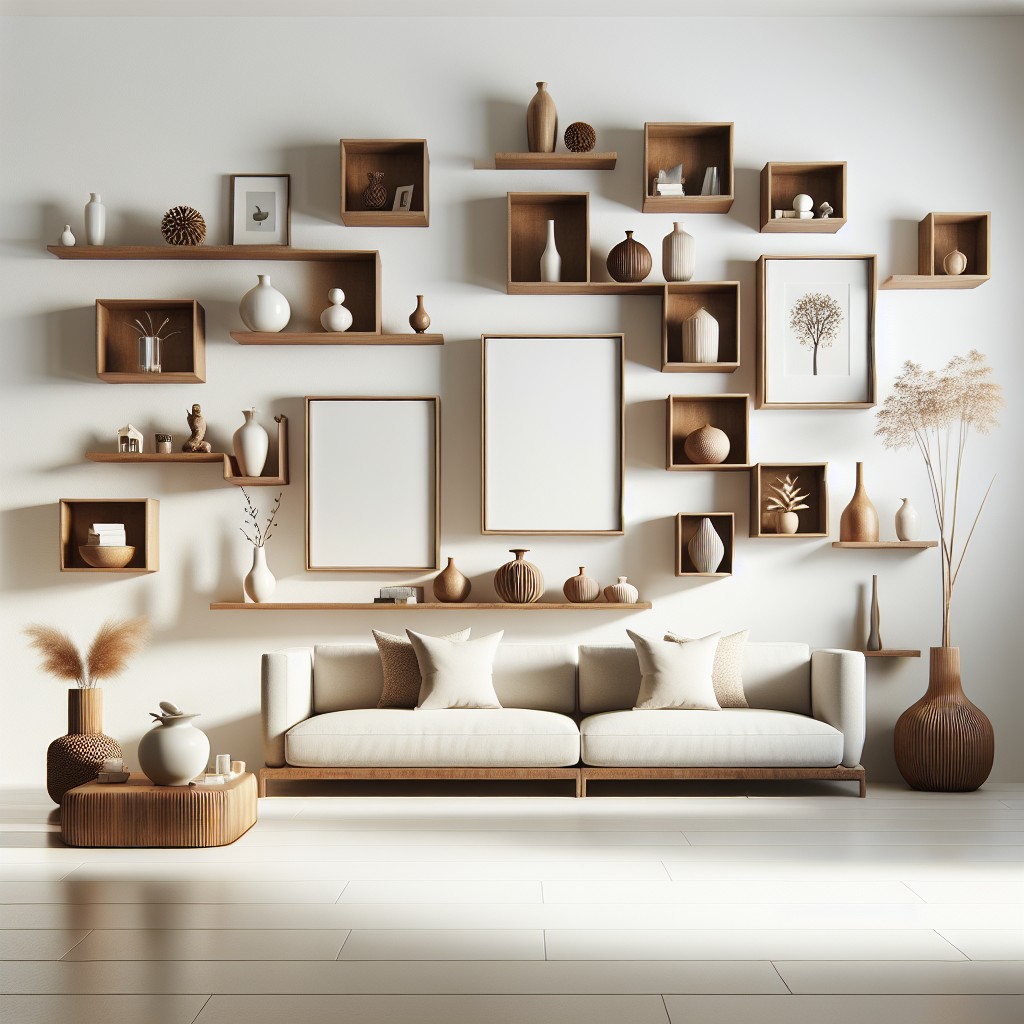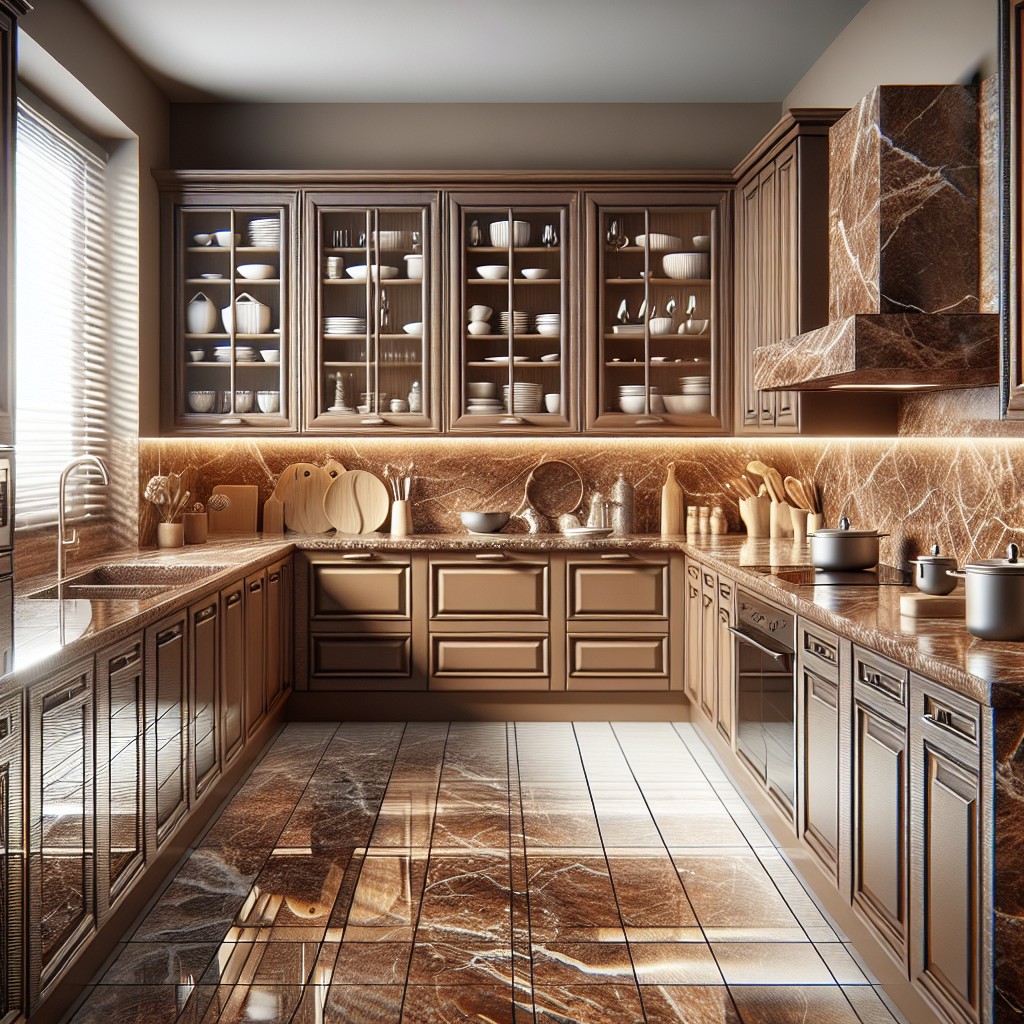Last updated on
Floating shelves should typically range between 6 to 12 inches wide, but the optimal size will largely depend on factors such as the intended use, the space available on the wall, the type of bracket being used, and the thickness of the shelf itself.
Key takeaways:
- Floating shelves should range between 6 to 12 inches wide.
- Consider intended use, available wall space, bracket type, and shelf thickness.
- Balance aesthetic appeal with functionality, safety, and longevity.
- Standard depth is 8 to 12 inches for most items.
- Custom floating shelf measurement basics: length, depth, thickness, clearance, wall stud location.
What's Inside
Depth Recommendations

When determining the depth of your floating shelves, consider both function and proportion. A standard depth is typically between 8 to 12 inches, sufficient for displaying framed photos, books, and decorative items.
For kitchen shelves, a depth of 10 to 12 inches allows for storing most dishes and appliances comfortably. If you’re planning to place heavier objects or bulkier items, such as large plants or audio equipment, opt for a sturdier shelf that can accommodate the added weight.
Remember, too deep can make shelves appear bulky and obstructive, while too shallow may limit their practical use. Always measure the items you plan to place on the shelf to ensure a perfect fit.
Custom Floating Shelf Measurement Basics

Measuring for custom floating shelves involves precision to ensure a perfect fit and optimal functionality:
1. Measure Shelf Length: Start by measuring the length of the wall space where you plan to install the shelf. Leave a couple of inches on each side to avoid a cramped look.
2. Determine Depth: Based on what you plan to display or store, decide on the depth of the shelf. Typically, a depth of 8 to 12 inches serves most needs.
3. Consider Thickness: The thickness of the shelf contributes to its strength. A thicker shelf can often support more weight.
4. Note Clearance Space: Account for doors, windows, or any other elements that may interfere with the shelf. Ensure there is enough clearance around these features for easy access and aesthetic harmony.
5. Wall Stud Location: Identify the locations of wall studs for secure mounting, especially for wider and heavier shelves, as they provide additional support.
6. Tool Up: Have a tape measure, level, and pencil handy for accurate measurement and to mark drill points prior to installation.
By attentively following these guidelines, you set the stage for shelves that are not only visually pleasing but also functionally sound.
What Will I Store On My Wood Shelves?
Consider the items you plan to display or store when deciding on the width of your floating shelves. Heavier, bulkier items like large books or kitchenware require sturdier, deeper shelves, typically around 10 to 12 inches. For lighter, decorative objects, narrower shelves of 6 to 8 inches suffice. Assessing your storage needs beforehand ensures that your shelves aren’t just visually appealing but also functionally relevant, catering precisely to the demands of your belongings.
Where Will I Install the Custom Floating Shelves in My Space?
Deciding on the installation spot for your floating shelves involves evaluating purpose and aesthetic. In the kitchen, shelves often hover above countertops or sinks, ideally positioned within arm’s reach for practicality. For living rooms or offices, consider eye-level placement to feature decorative items or books. In a bathroom, shelves might serve best near the vanity to hold toiletries and towels.
Ensure there’s ample clearance space around the area so doors and appliances can operate unobstructed. Remember to leave enough headroom on shelves meant for seating areas to avoid accidental bumps. Lastly, be mindful of wall studs’ locations — they offer the most support for anchoring shelves, particularly for heavier loads.
The Ideal Depth of Floating Shelves
When determining the ideal depth for your floating shelves, consider the items you plan to display or store. A depth of 8-12 inches caters to most books and standard-sized frames, ensuring they sit comfortably without overhanging. For kitchenware or larger items, a 10-14 inch depth provides ample space, accommodating most dinner plates and serving dishes. In bathrooms, narrower shelves, around 6-8 inches, are sufficient for toiletries and smaller decorative items.
It’s essential to balance the shelf’s function with its location. Shelves in high traffic areas should lean towards a narrower profile to prevent obstruction. Contrarily, in areas where space isn’t an issue, a deeper shelf can serve as a focal point, providing a substantive look and more significant storage capacity.
Measure the items you anticipate placing on your shelves beforehand. It’s better to have a bit more depth than needed rather than realizing your items don’t fit after installation. Keep in mind that excessively deep shelves can appear bulky and disrupt the harmony of the room’s aesthetics.
Understanding the Weight Capacity of Different Shelf Depths
Before selecting the depth for your floating shelves, consider the weight they’ll need to support. Shelves with a greater depth offer more surface area, allowing them to hold heavier items if properly supported.
Key points to remember:
- Thicker brackets and a sturdier wall anchor system are necessary to maintain the shelf’s integrity under heavy weight.
- The shelf’s material influences its weight capacity. For example, solid wood can bear more weight than particleboard.
- Increased depth improves stability, reducing the risk of sagging over time when used with appropriate hardware.
- Consult manufacturer guidelines for maximum weight capacities based on shelf size and material to ensure safety.
- Regularly assess shelf stability and tighten hardware as needed to prevent accidents and maintain efficiency.
Matching Shelf Width to Wall Length for Aesthetic Balance
When deciding on shelf width, consider the length of the wall where you’ll mount them. Ideally, shelves should not span the entire length; instead, leave a gap on each side to create a framed look. For long walls, a rule of thumb is to opt for shelves that take up two-thirds to three-quarters of the wall space. This provides a harmonious proportion while allowing room for wall art or other decorative elements.
For shorter walls or in a smaller room, you might go slightly wider in proportion to the wall to maximize storage and display space. In such cases, a gap of 6 to 12 inches on either end may suffice. It’s also worth noting that multiple shorter shelves staggered or spaced apart can create visual interest and a less cluttered look than one long shelf.
Remember to keep the shelf width proportional to the space—a shelf that’s too wide in a narrow corridor might hinder movement, while too narrow a shelf on a large wall might look lost. Balance is key, ensuring that the floating shelves not only serve a functional purpose but also enhance the overall aesthetics of the room.
Maximizing Space With Proper Shelf Width in Small Areas
Utilizing every square inch is crucial in confined spaces. Choose shelf width that complements the room’s scale without overwhelming it.
Here’s how to achieve the perfect fit:
- Measure the wall space, reserving a few inches on each side to avoid a cluttered look.
- Opt for multiple narrow shelves stacked vertically to draw the eye upward, creating an illusion of height.
- Consider the room’s flow; allow for ample space for movement around the shelves. Avoid extending shelves into areas where they may impede traffic.
- Prioritize the essentials. Store the most frequently used items at arm’s reach, and use higher shelves for less-used belongings.
- Think bespoke. Custom-sized shelves can be crafted to fit niche spaces – like above a desk or in an alcove.
- Employ corner shelving to capitalize on often underutilized spaces, making them functional and stylish.
Integrating Shelf Width With Overall Room Design
When selecting the width of your floating shelves, consider the layout and features of the room to create a cohesive look. Follow these guidelines:
- Scale to Furniture: Align shelf width with key furniture pieces below, such as a sofa or a bed, to maintain balance.
- Grouping: For a dynamic visual effect, group narrower shelves together. This allows for flexibility in display options and creates visual interest.
- Negative Space: Leave ample space between multiple shelves and around the perimeter to avoid a cluttered look and to let the wall itself be part of the design.
- Symmetry vs. Asymmetry: Symmetrical arrangements exude calmness, while asymmetrical setups provide a modern, eclectic vibe. Decide which suits your room’s character.
- Focal Point: A wide shelf above a fireplace or TV stand can serve as a statement piece. Assess the room’s natural focal point to choose an appropriate width.
- Continuity: If the room has existing shelving, match new shelves to these dimensions to create a sense of continuity.
This approach to selecting shelf width ensures your floating shelves not only serve a functional purpose but also complement and enhance your room’s design.
Installation Tips for Wide Floating Shelves
When installing wider floating shelves, it’s crucial to ensure stability and safety. Locate the studs in your wall using a stud finder, as attaching the shelf to these will provide the best support. With wider shelves, it’s especially important to distribute the weight evenly, so secure the mounting bracket across several studs if possible.
Use a level while installing to make sure your shelf sits perfectly horizontal. This prevents items from sliding off and ensures an aesthetically pleasing appearance. Additionally, for shelves wider than 36 inches, consider adding extra support with concealed brackets or a support ledge underneath to prevent sagging over time.
For drywall, heavy-duty anchors are a must for areas where studs are not available. Make sure the anchors you choose are rated for the weight you plan to place on the shelf.
Having a partner can be incredibly helpful to hold the shelf in place while you mark the positions for the mounting hardware. Finally, follow any specific instructions provided by your shelf manufacturer, as these will be tailored to the design and materials of your particular shelves.
FAQ
How wide should my floating shelf be?
For kitchen use, a floating shelf should ideally be around 12″ wide to accommodate common kitchenware and align well with standard cabinet depths.
What is a good depth for floating shelves?
A good depth for floating shelves is 11 inches for most dinnerware, and 12 inches for larger dinnerware and heavy-duty items like pots and pans.
What is the rule for floating shelves?
For optimum visual flow and spacing of items, floating shelves should be spaced between 11 to 17 inches apart, either in a staggered manner or a straight line based on personal preference.
What is the best layout for floating shelves?
The optimal layout for floating shelves is positioning them behind the couch in the living room, where they can host a variety of decorations or everyday items like candles and coasters.
Are there specific guidelines for spacing between floating shelves?
Yes, the typical space between floating shelves is usually between 16 to 18 inches, but it can be adjusted depending on the size and number of items you plan to display.
How does the material of the shelf affect its width and durability?
The material of the shelf heavily influences its durability and potential width, as robust materials like metal or solid wood can support larger widths and offer longer durability than less durable materials like particle board or plastic.
Is there an optimal weight limit for floating shelves based on their width?
Yes, floating shelves typically have a weight limit depending on their width with a general guideline suggesting a weight capacity of 15-30 lbs per foot for shelves that are 24-36 inches wide.





